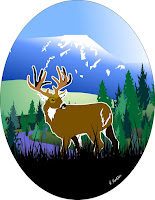Deer communicate with each other by three basic means. By far the most common form of deer communication is by scent, followed by vocalization. Far less known is that deer also communicate through behavioral patterns. Behavior patterns are very complex, in fact so much so that the common term “body language” has evolved. However, for the sake of simplicity I only will focus on a few of the most common behaviors that hunters witness quite often. I will explain what they mean and what the deer are “telling” you with it.
 |
| ©Heidi Koehler |
Behavior:
The deer stands still with its ears pointed forward and is directly staring at you. In this position the deer sometimes flicks its tail up and down in conjunction with head bobbing, or moving the head from side to side. In high alert mode the deer will also stomp the ground with one of its front feet.
Meaning:
The deer has seen something that caught its interest and is now alert but does not know what exactly it is. The head bobbing and tail flicking has two meanings. A.) The deer tries to entice the object to move. For example, predators often move at the sight of rapid movement. B.) By moving the head from side to side and flicking the ears the deer tries to see the object from different angles and pick up the faintest sound with its ears. Stomping the foot on the ground also serves to alert the other deer within earshot.
What to do?
This is a situation where most hunters go “I’m busted” and walk away. Now you are busted because the deer has seen you move. What you should do is to stand absolutely still. Avoid direct eye contact; deer seem to have a sixth sense for being stared at and they don’t like it. It can take several minutes until the deer is convinced that you’re not an immediate threat and either will slowly move off or resume its normal activity. If the deer moves calmly away, flicking its tail ones or twice, signalling ‘all is well’, remain in your position a while longer and then try to follow the deer quietly.
 |
| ©Heidi Koehler |
Behavior:
Instead of carrying his tail in a normal relaxed fashion the buck has tucked his tail firmly between its legs. As he wanders about he constantly looks around as if he is being followed. The overall behavior of the deer seems edgy and nervous.
Meaning:
Bucks have a very strict hierarchy; to avoid physical conflicts the lower ranking animals act submissive and are very cautious. If a dominant buck is in close proximity the lesser buck will increase the submissive behavior a notch by lowering the head slightly and letting his ears hang down. If you see such a buck close to a doe and he suddenly moves off it is a sure sign that the big boy is very close by, even if you can’t see him yet.
What to do?
If the buck is legal you can take him if he presents a shot. Or, you can wait for the dominant buck to appear. The more tense and skittish the buck acts the closer the big boy will be. Wait him out. If you see a lesser buck in a field near a doe suddenly moving off without apparent reason while looking into a particular direction start to pay attention in that direction, the big one may step out any minute.
 |
| ©Heidi Koehler |
Behavior:
This buck carries his head high, rump and neck hair bristling as he marches around his domain. There are only two scenarios where this buck will lower his head as a behavioral gesture. One is in a semi-submissive position when he approaches a doe in heat. The other is an aggressive gesture with the hair on his neck and rump standing upright when he approaches a contender. Often this behavior is accompanied by several deep guttural grunts.
Meaning:
This buck is the undisputed monarch of the deer woods and has first pick of every doe that comes into heat. Except for the mature does all other deer are intimidated by him and have to wait at the sidelines until this buck has picked the doe he wants or had his fill at the waterhole. Every buck in the area is well advised to keep a healthy distance from him.
What to do?
If he is outside your comfortable shooting range you can bring him closer with a challenging buck grunt or some antler rattling. The dominant buck is quite often a younger deer in the prime of its strength, endurance and stamina.
 |
| ©Heidi Koehler |
Behavior: The buck pins his ears back close to his head, with the nose high up as he audibly sucks in air through his mouth and blows it out through the nose as he scent-checks the air. On the move the buck hastily walks along with the head stretched far forward and nose to the ground, like a bird-dog, following a scent trail.
Meaning:
The buck has heard a sound or caught a whiff of scent that excites him and he is ready for action. The cause for this behavior can be from a doe in heat or a strange buck that has entered his turf.
What you can do?
If this behavior is mixed with aggression the buck has caught the scent of an intruder. Use an aggressive grunt call to bring him to your stand. If the behavior is sheer excitement, the buck follows a scent trail of a hot doe. In this case you can use a doe-in-estrus bleat to bring him in.
As I mentioned at the beginning of this article, studying animal behavior is a fascinating subject and by deciphering the meaning of it can get you a giant step closer to filling your tag with consistency every year.

No comments:
Post a Comment